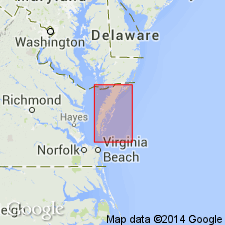
- Usage in publication:
-
- Butlers Bluff Member*
- Modifications:
-
- Named
- Dominant lithology:
-
- Sand
- AAPG geologic province:
-
- Atlantic Coast basin
Summary:
The middle member of the Nassawadox Formation, pale-gray to yellowish-gray, fossiliferous, fine to coarse, pebbly, clean, cross-bedded sand, is here named the Butlers Bluff Member. Conformably to disconformably overlies the Stumptown Member of the Nassawadox; extends westward in the subsurface beneath the Franktown plain where it underlies the Occohannock Member of the Nassawadox; underlies the southern Delmarva upland. Thickness at type section is 30 ft (9 m). Age is Pleistocene.
Source: GNU records (USGS DDS-6; Reston GNULEX).

- Usage in publication:
-
- Butlers Bluff Member
- Modifications:
-
- Overview
- AAPG geologic province:
-
- Atlantic Coast basin
Summary:
Nomenclature on State map follows Mixon (1985). Butlers Bluff is middle member of Nassawadox Formation, underlying the Occohannock Member. Unit is described as pale-gray to light-yellowish-gray, fine to coarse, cross-bedded, pebbly sand and sandy gravel comprising surficial deposits of upland (altitude 35 to 40 ft). Contains diverse molluscan assemblage in lower part including MARGINELLA, MULINIA, NASSARIUS, SPISULA, PLEUROMERIS, and OLIVELLA, which indicates a shallow, nearshore-shelf depositional environment. Unit was deposited as a southward-building complex of spit-platform sands and shallow shoals and is as much as 60 ft thick. In subsurface overlies Stumptown Member (not mapped). Age is late Pleistocene.
Source: GNU records (USGS DDS-6; Reston GNULEX).
For more information, please contact Nancy Stamm, Geologic Names Committee Secretary.
Asterisk (*) indicates published by U.S. Geological Survey authors.
"No current usage" (†) implies that a name has been abandoned or has fallen into disuse. Former usage and, if known, replacement name given in parentheses ( ).
Slash (/) indicates name conflicts with nomenclatural guidelines (CSN, 1933; ACSN, 1961, 1970; NACSN, 1983, 2005, 2021). May be explained within brackets ([ ]).

